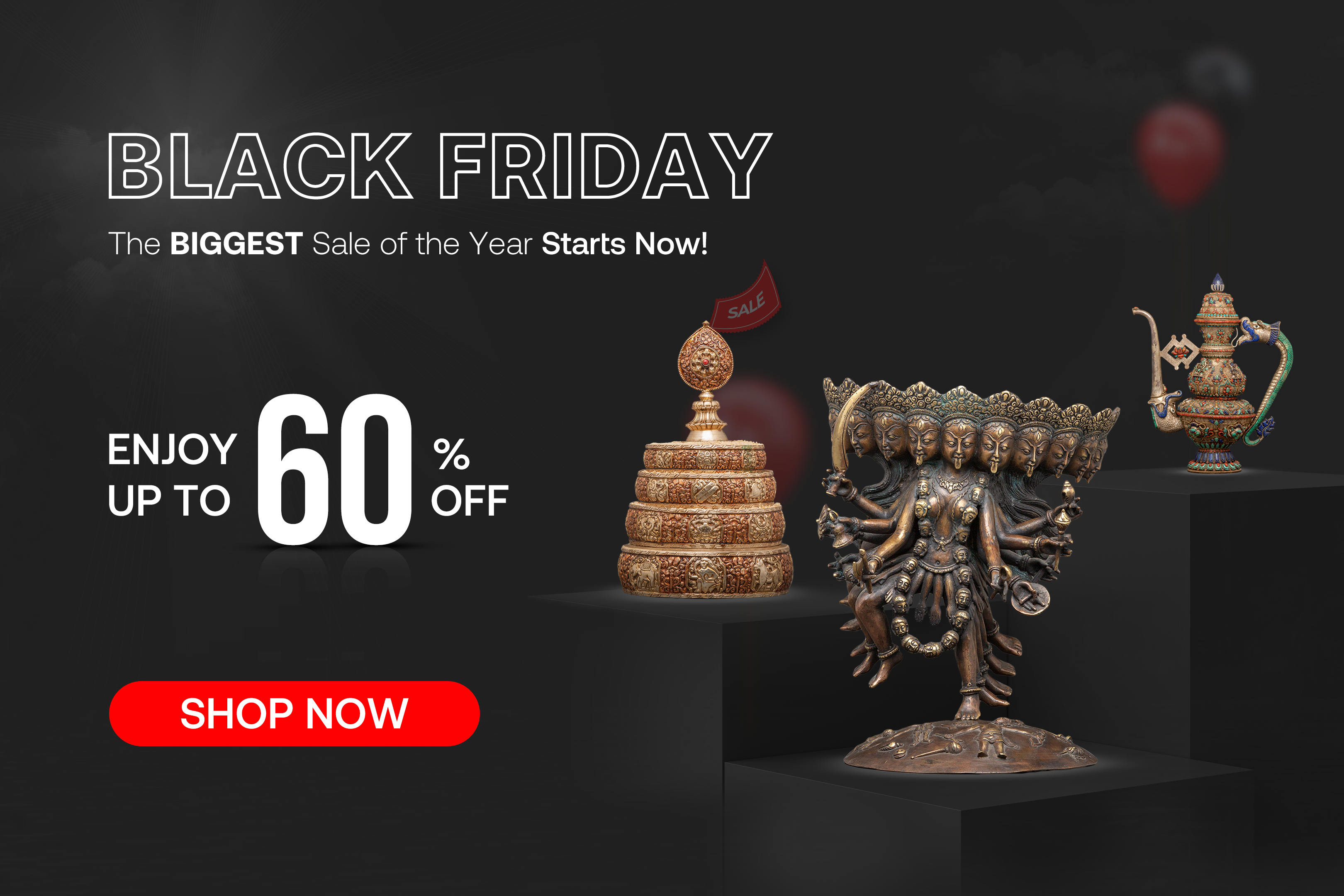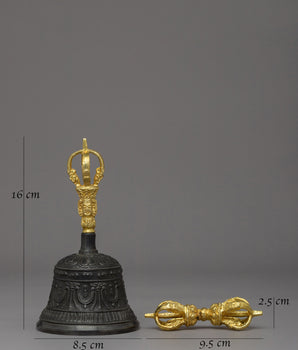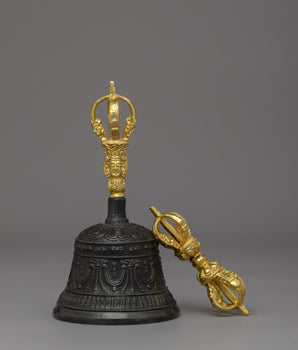Introduction To The Profound Symbols of Vajrayana Buddhism
Symbolism plays a significant role in Vajrayana Buddhism having a particular and profound meaning behind them. In Buddhism, the Symbols represent the expression of deities, either a peaceful form or a wrathful one.
As per their respective expression, these deities hold different objects. The one with peaceful forms usually holds emblems such as gems, scriptures, and lotuses. While the wrathful holds objects like the goad, the mace, the skull, the kartri, and objects similar in nature.
Below is the list of the symbols that are commonly depicted in Buddhist Thangka paintings and sculptures.
- Vajra
- Khadga: Sword
- Vishvavajra
- Vajrakila: dagger
- Vina: Lute
- Pundarika: Lotus
- Conch: Purity of Buddha’s speech
- Dhanusa: bow
- Dharmacakra
- Damaru: drum
- Padma: Lotus
- Kalasa: Vase
- Kapala: Skull cup
- Pindapatra: Alms bowl
- Ghanta: Bell
Vajra, Dorje

The Vajra is one of the primary objects held by deities. In Sanskrit, it is defined as ‘hard or mighty one’ having meanings of both thunderbolt and diamond and in Tibetan, it is termed as ‘Dorje’ meaning ‘lord of Stones’.
In the context of Vajrayana, it symbolizes emptiness- ‘the mighty weapon for destroying defilements’. Deities like Vajradhara, Vajrasattva, and Vajrapani can be seen holding the Vajra. It is wielded to eliminate obstacles to enlightenment.
The Vajra is formed out of brass or bronze. Structure wise it has three or five or nine prongs curving towards the central axis, centered on a vase-like midsection. Three-pronged forms are most common in iconography. During the rituals, the practitioners use Vajra in conjunction with the bell.
Khadga: The Sword

The sword is often connected with the Bodhisattva Manjushri. It represents the wisdom that cuts through all beings' ignorance. The flame covers both ends of the sword with a dragon around it. The ego and ignorance is the root cause of suffering. The dragon represents the ‘sword of the wisdom of emptiness’ that kills the delusion of one's ego and ignorance just as lighting destroys the darkness.
The sharp edges of the sword on both ends signifies its ability to destroy both inner and outer Maras. According to Swayambhu Purana, it is believed that Manjushri cut the gorge of Chovar with his Chandrahas sword which then drained the Kathmandu valley resulting in the place as habitable.
Vishvavajra, The Double Vajra

Vishwavajra is also referred to as double dorje. It is often associated with Amogasiddhi, one of five Dhyani Buddhas. It is considered an emblem of protection and stability signifying the ‘all accomplishing wisdom of all Buddhas’. Varja in Sanskrit represents both thunderbolt and diamond.
Double Dorje is frequently used in Buddhism in both two-dimensional and three-dimensional forms, with its dual meaning of stability and protection from evil, deceit, and temptation. It is made out of four lotus-mounted Vajra-heads emerging from a central hub in four directions.
Mother Namgyalma (ushnisavijaya) holds this double Vajra with her main hands.
Vajrakila: The Ritual Dagger

Vajrakila is a ritual dragger mainly used in Tantric ceremonies by practitioners. It is infused with the power of a yidam to eradicate all negative energies, violence, hatred aggression, and sickness.
It is termed ‘phurba’ in Tibetan, and ‘Kila’ in Sanskrit. The dagger has three faces on the upper half and a pointed end with three blades. The dagger as a whole signifies the ‘worlds axis’. The sections and the three blades represent the three spirit world.
The Phurba radiates ferocious, wrathful, piercing, and captivating energy. It is made up of different materials. It could be clay, woods, different metals, monkey or human bones, or any appropriate combination that is said to be a powerful element to dispel evil spirits.
Vina: Lute

Vina is a stringed musical instrument. Vina has a simple yet strong semblance. If the strings of Vina are too tight or too loose, it will sound too odd. One won’t be able to hear what he/she wants to. In a similar context, to achieve the rightful meditation, one must not be too earnest nor too careless. There must be a balance in every aspect to achieve a fruitful result.
Vina is often seen handled by Saraswati. She is called Yangchen Lhamo or Yangchenma, the goddess of music and melody in Tibet. She is represented mainly in two colors, red and white. In her red form, she is portrayed as a powerful deity. The white form signifies her wisdom and learnings.
Click here to view Mother Saraswati, holding a Vina.
Pundarika: The Lotus

The Pundarika signifies purity, spiritual awakening, and faithfulness and it has thousands of petals with pistils of five colors. The different stages of lotus flowers have different meanings. A fully blossoming lotus flower represents enlightenment, a close bud symbolizes one time before enlightenment and the partially open center hidden implies that enlightenment beyond ordinary sight in Buddhist art.
Although the Lotus blooms from the muddy bottom of the lake, it rises above the mud with a fragrant, undefiled by the mud. Similarly, though the Buddhist Dharma is a root in the afflictions, the one practicing it is not flawed.
The Conch Shell

You can view this amazing Conch shell, click here
The Conch Shell symbolizes the teachings of Lord Buddha, Dharma. It is one of eight auspicious symbols of Ashtamangala. The conch as a musical instrument is used for religious ceremonies to this day in Tibet. Practitioners believe blowing a conch increases positive mental vibrations of the mind including faith, enthusiasm, determination, and fearlessness.
The conch shell depicts Lord Buddha’s melodious voice. Not only as it is used as a musical instrument, but also used as a container for holy water for rituals. The significance of conch shells in India’s Vajrayana Buddhism led to its adoption in Tibetan Buddhism.
Dhanusa: The Bow

The Dhanusa is the representation of mental control and its clarity. If one holds a bow sluggishly and tries to hit the target he/she won’t be able to strike. This is correlated with the practitioner won’t be able to seek and find the ultimate truth without a controlled mind. The mind is the most important attribute of a sentient. He/ She must have the right sense of it to achieve the truth.
The Dhanusa consists of a bow and arrow. These two items are carried and held together. This symbolizes the union of wisdom and compassion and hence enlightenment. The drawing of an arrow from a bow represents focused and spontaneous action and intelligence.
Dharmacakra: The Dharma Wheel

Dharmachakra means ‘Wheel of Dharma’ in Sanskrit. This is often termed a ‘gesture of teaching of the Wheel of Dharma’. It represents a pivotal moment in Buddha’s Life. Gautama Buddha performed this mudra in his first sermon in Sarnath after attaining enlightenment where he set Buddhist Law (Dharma) in motion. To perform Dharmachakra mudra, practitioners touch the thumb and the index fingers of both hands to form a circle that represents the Wheel of Dharma.
The Dharma wheel is divided into three major parts, hub, rim, and spokes. The hub signifies moral discipline, the rim signifies meditative concentration and mindfulness, and the spokes represent the Eightfold path. The circular shape of the dharma wheel means the perfection of Buddha’s teachings.
Damaru: The Small Hand-drum

Damaru is widely held by the most tantric deities. It is a two-headed tiny drum that is regarded to emit power and spiritual energy when played. The two heads are covered tightly with a skin membrane held in position by string wrapped around the body. The skins are cured using traditional methods of burying them for two weeks in a mixture of copper and other mineral salts, as well as unique herbal formulas.
It has a different mantra inside inscribed in gold. The symbolism and energetic properties of this instrument are boundless. Skull damaru, and Chod damaru are some of the types used by practitioners. They use the drum in different rituals as a customary right hand as a companion to the bell on the left hand.
Kalasa: The Long-life Vase

Kalasa represents longevity as it is filled with the nectar of immortality, Amrita. It is widely used by Vajrayana Masters for invocation of the deities. There is numerous interpretation of Kalasha such as a symbol of fertility, birth, creation, richness, and wealth.
The precious nectar of immortality, amrita is interpreted differently by a Tantric practitioner and a regular practitioner. For Tantric practitioners, it represents the freedom from one cycle of life and death while for the regular practitioner it means the essence of long life.
Kapala: Skull Cup

Kapala in Sanskrit means ‘skull’. In Buddhist Tantra, it is used as a ritual bowl. It is a symbol of tantric deities and Dharmapala. The use of kapala in Tantric rituals represents the transition of delusion into perfect wisdom. Practitioners in Tibet use the skull cup filled with dough cakes and wine resembling flesh and blood respectively as sacrifices to wrathful deities. The dough cakes are usually in the shape of human eyes, tongues, and ears.
Deities like Mahasiddhas, Dharmapala, and Dakinis are portrayed holding a Kapala mostly on the left hand. The modern-day cups are made up of brass, still embodying the shape of a human skull and decorated with different motifs. Practitioners use it during higher Tantric meditation as it is believed to aid transcendental states. The cup is decorated and kept on a triangular pedestal.
Pindapatra: Alms bowl

The alms bowl is specially used by those monks who have transitioned from ‘home life’ to ‘homelessness. The Buddhist monks are referred to as ‘Bhihkku’ in the Pali language meaning, ‘one who lives on alms’. Practitioners are provided with food, robes, medicine, and shelter from time to time.
This practice dates back for centuries, since the time of Lord Buddha as it can be seen in ‘Pindapataparisuddhi Sutta’. The process of alms giving acts as a medium of connection between Buddhist monks and humans. In return for almsgiving, the monks advise people, to give Buddhist teachings, the concept of learning to give and let go and provide spiritual guidance.
Ghanta: Bell

Ghanta is regarded as one of the powerful meditational and ritual symbols in Buddhism. During the rituals or Vajrayana Tantric practice, Ghanta alongside dojre is used in conjunction. The Dorje is held in the right hand and the bell is in the left and is never isolated from one another. The bell represents the feminine principle as the ‘perfection of wisdom which directly perceives emptiness (shunyata). It is defined as "proclaiming the sound of nothingness," which originates from the voidness of its shape, radiates in all directions, and then dissipates back into silence or emptiness. Its hole, or mouth,' represents nothingness, while its clapper, or 'tongue,' represents the shape.
Practitioners who meditate with Bell and Dorje interact with the symbolic collection of Buddha’s teaching. The face of Wisdom Prajnaparamita appears on the Bell's handle at the highest level. 'The Dorje is Yidam in our hands: compassion and technique, symbolizing the five masculine perfections and the Bell are Mandala, signifying the complete knowledge Mandala.’ The Ghanta is molded using a traditional sand-casting method from bronze bell metal. There is an inward tapering rim at the base of a bell from where the ‘sound of emptiness’ resonates.















